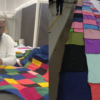How The Fast Fashion Industry Affects The Lives of Garment Workers
How The Fast Fashion Industry Affects The Lives of Garment Workers
The beautiful, edgy, “trendy” new looks; the ever-changing fashion trends; the oh-so-stylish outfits! We all gel tempted by them. We all, at some point, have felt FOMO for not having the latest wardrobes.
This is how mainstream brands have created a toxic cycle of over-consumption. They generate new and catchy designs every day. These are non-evergreen designs made out of poor quality materials. They want us to keep buying new ones.
This cycle is called Fast fashion – mass production of recent catwalk designs at low costs, quick release to markets at low rates, creating high demands, and repetition.
The people involved in producing these garments are skilled laborer’s from Bangladesh and India. Economically poor sections of these countries, to be specific. People of these sections are desperate to make a living, and brands monetize on their misery.
They work long, continuous hours for unacceptably low wages. Because low production cost and high speed are the two pillars of this industry, both the pillars stand tall on the weary shoulders of the garment workers.
Here’s how the fast-fashion industry affects lives of garment workers.
1. They get paid nearly 1/5th of the living wage!
Read that again.
2. They do not receive any employee benefits.
After working for ungodly hours in poor work conditions and getting paid peanuts, these workers do not gel the minimum employee rights such as insurance.
3. Their lives are not valued.
As if the wage and work conditions were not enough exploitation already!
In 2013, a garment factory in Dhaka, Bangladesh, collapsed, killing over a thousand and injuring more than two thousand garment workers.
Five months before that incident, over a hundred workers lost their lives trapped inside a burning factory in Dhaka, Bangladesh.
Yet the fast-fashion industry is continuing its exploitation and slavery.
We all know that fast fashion exists because it’s trendy and cheap.
But are the lives of these workers that cheap?


